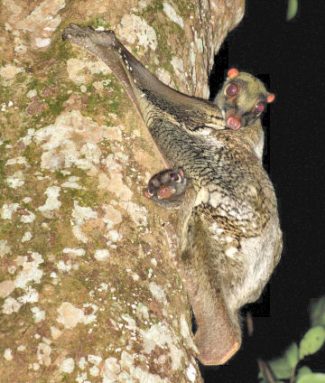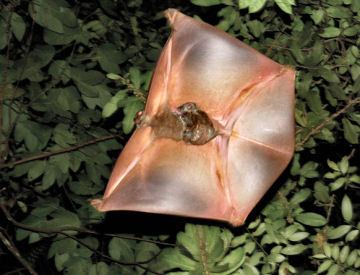Gliders in the family
Two rare gliding mammals may be the closest living relatives of modern primates.
By Emily Sohn
Watching monkeys at the zoo can be fascinating because the animals’ actions are so similar to those of people. Along with gorillas, orangutans, lemurs, and others, monkeys belong to a group of mammals called primates. People are primates, too.
Now, scientists have discovered that two rare species of mammals, called colugos, are very nearly primates—but not quite. The new study suggests that these small animals are the closest living relatives of modern primates.
 |
|
Two colugo species may be the closest living relatives to modern primates. Above, a Malaysian colugo mother shelters a youngster. Below, a colugo leaping off a tree snaps open a membrane that allows it to glide a long way to the next tree.
|
| N. Lim/National University of Singapore |
 |
|
|
| N. Lim/National University of Singapore |
The discovery gives insight into the evolution of primates—and people, say the scientists, from Texas A&M University in College Station.
“Having the closest relative really allows us to understand the change of events that led to primates,” says lead researcher William Murphy. That should help us “better understand the changes that make us human.”
Colugos live in rain forests. One of the species included in the recent study lives in the Philippines. The other lives in Southeast Asia. Like flying squirrels, colugos can stretch out winglike membranes, allowing them to leap off trees and glide for up to about 70 meters (230 feet).
On the basis of recent research, scientists suspected that a common ancestor that lived long ago eventually developed into colugos, primates, and a type of animal called the tree shrew. But determining the order of evolution has been difficult.
To help straighten out the story, Murphy and colleagues looked at the genetic material DNA from 36 animal species, including primates, dogs, and bats. DNA is a complicated molecule that serves as an instruction manual for life. Parents pass DNA down to their kids. And the molecule changes from generation to generation.
The exact arrangement of DNA differs among individuals of a species. Despite these differences, members of a species share enough DNA that scientists can tell species apart by looking at their genetic material. The more closely related two species are, the more DNA they have in common.
After comparing a special kind of DNA among the mammals in its study, Murphy’s team concluded that tree shrews branched off from the ancient ancestor first. Colugo DNA changed later, making these little gliders our closest cousins outside of the primate family.
Experts’ reactions to the new work have been mixed. The conclusions make sense, they say, but it would help to have more detailed analyses.
Scientists who want more evidence may have their answers soon. Some 30 evolutionists are now working together on a mammal tree of life—the biggest study yet of how mammals are related to one another.







